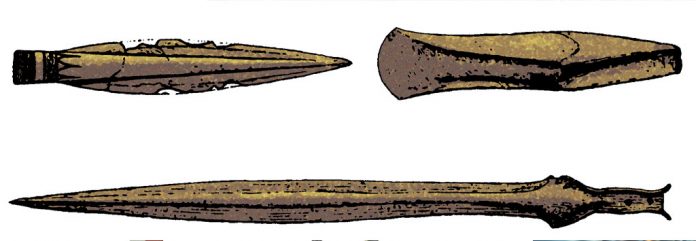Jennifer Wexler, Bronze Age Index Manager, MicroPasts Project, Daniel Pett, ICT Advisor, Portable Antiquities Scheme, and Neil Wilkin, Curator of European Bronze Age collections, British Museum
As any museum researcher will tell you, getting used to a new museum is as much about learning about the collections of objects, as chasing down the paper records that accompany them. These can yield vital clues about how and where important finds were made and how their biography unfolded. Last winter the MicroPasts team (a collaborative, multi-disciplinary AHRC-funded project with University College London‘s Institute of Archaeology) assembled at Franks House, to view the British Museum’s Bronze Age collection. Our visit was the inspiration for an exciting new project to digitise one of the first catalogues to document British and European prehistory: the Bronze Age Index.
The history of the Index is filled with periods of inactivity punctuated by rapid developments. It began as a major archaeological initiative founded by the British Association Committee on Bronze Implements in 1913 and originally housed at the Society of Antiquaries at Burlington House on Piccadilly. It was moved to the Department of British and Medieval Antiquities at the British Museum in 1933, though it was sent on loan to the former British Museum curator Professor C F C Hawkes, as acting Chair of European Archaeology at Oxford University in 1955. It was finally returned to its permanent home at the British Museum in 1966, where it has been kept ever since.
Known as the ‘principal instrument of research in the British Bronze Age’, the main concept behind the creation of the Index was the idea that by compiling a corpus of all Bronze Age metal objects found in the various museums and collections across the UK, it would be possible for the first time for researchers to study ‘the movements of peoples and trade through the exhaustive study of the distributions of certain types of implements and weapons used in the period’. This corpus took the form of an illustrated card catalogue, with each index card detailing object findspots and types, alongside detailed line drawings and a wide range of further information about the object’s context of discovery, illustrated below. For over 70 years, it represented the highest standards of Bronze Age object studies.
The Bronze Age Index now contains over 30,000 records of Bronze Age tools and weapons largely discovered during the 19th and 20th centuries, and complements our current Portable Antiquities Scheme (PAS) Database of metal object finds. This initiative is interesting not only because it was the first catalogue of its kind documenting prehistory on a wide scale, but also because it was probably the first British archaeology initiative to call on public help with documenting British prehistory way back in the early 20th century.
Following in the footsteps of creators of the Index, we are once again calling on the public to help us research this extremely important untapped resource. Since late 2013, the digitisation of the entire Index has been undertaken by the MicroPasts project. The MicroPasts project employs a crowd-sourcing platform (built on the open source project Pybossa) in order to solicit help from members of the public or ‘citizen archaeologists’ to assist us transcribing the important information contained on these cards. Additionally, people are helping us with creating 3D models of objects, many of which are recorded by the Index. By undertaking these transcriptions, it will be possible to incorporate the Index’s 30,000 records rapidly into the PAS database, which on its own includes nearly one million objects collected by the public, usually by metal-detectorists.
The result will be the largest national database of prehistoric metal finds anywhere in the world and a near-comprehensive view of what we currently know about such finds in the UK. Metal finds are not only crucial forms of evidence for dating Britain’s prehistoric past, but also tell us a great deal about prehistoric society and economy. The creation of this database will allow for the rethinking of almost everything we currently know about the use of metal in Bronze Age Britain, giving us a more comprehensive view of our prehistoric past. It is also fascinating as it should demonstrate how the interplay between reassessing archaeological archives and the employment of new technologies, such as crowd-sourcing, can open up new avenues of research and public engagement.
If you are interested in helping us research and enrich our knowledge of the Bronze Age, as well as many other museum archives, please join us and help to realise the aspiration of 100 years of Bronze Age study.
The MicroPasts project team is led by Professor Andy Bevan (Institute of Archaeology (IOA), UCL) and co-investigated by Daniel Pett and Rachael Sparks (IOA, UCL). The British Museum Bronze Age Index is managed by Jennifer Wexler in collaboration with Neil Wilkin and Chiara Bonacchi (IOA, UCL) and Adi Keinan-Schoonbaert (IOA, UCL) are the principal researchers.
The Project is supported by the Arts and Humanities Research Council.









